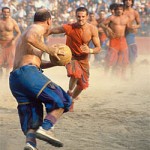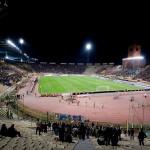It’s a tired but true observation that to understand Italy and the Italians, you have to at least take a passing look at football and its place in society.

some theories suggest calcio fiorentino is the root of modern football -though it looks closer to rugby
Whether you subscribe to the theory that the game was actually invented in Italy – either as calcio fiorentino or the ancient Roman game of Harpastum – or the more generally accepted view that it was imported here at the turn of the 20th Century, it’s hard to argue with the fact that the game is almost absurdly popular in Italy.
Academic John Foot has written, for example, in his excellent history of the game in Italy – Calsio , a history of Italian football – that:
“football in Italy was not only a massive sporting phenomenon, but also something that reflected on, and affected, political, cultural and social trends. I started to understan that it was almost impossible to comprehend Italy without understanding football and vice-versa. This conviction crystallized in 1994, when Silvio Berlusconi made a dramatic entrance into political life with an organization – Forza Italia! – whose very name was taken from a football chant, and whose language was dominated by footballing terminology. Berlusconi, in his own words, had ‘taken the fileld’, he had ‘formed a team’ and he used his footballing success to bolster his political consensus. Football and Italian politics were not only linked, they were symbiotic, and it was unclear where the division between the two lay, if such a division existed at all.”

Bologna's Dall'Ara stadium is a classic example of the 1930s fascist architecture
So, even for the non-football-enthusiast taking in a game while you’re in Italy can be a memorable experience. Serie A kicks off this saturday, and while – sadly – Rimini are not in the major league (in fact, they have dropped down to Serie C1 this year after a disastrous season last year), the regional capital of Emilia-Romagna, Bologna, is. So, if you’re so inclined you could head inland this Saturday evening to cheer Bologna on against Fiorentina in the splendid and historic Dall’Ara stadium (a classic example of fascist architecture from the 1930s, when Serie A was adopted and promoted by Mussolini’s government officially).
Tickets are available in advance from branches of the Carisbo bank (Bologna FC sponsors) or at the stadium itself from 2.30pm on Saturday. You must produce valid ID to buy a ticket, following regulations introduced in 2005. The regulations also mean that spectators are subject to searches on admission, which slows things down a bit, so do turn up early. Kick off is at 18.00.
Tickets cost between €20 and €90 depending upon where you want to sit (cheapest tickets are in the home-side’s curva Giacomo Bulgarelli – directly behind the goal-mouth towards Via Andrea Costa).
To get to the stadium from Rimini you can take a train to Bologna, and then catch the #21 bus to Filanda (tickets can generally be bought on-board and cost €1)
This particular match, Bologna vs Fiorentina, has all the flavour of a derby given the proximity and rivalry between the two cities (Florence is just an hour away from Bologna, across the Appenines – or 2.5 hrs from Rimini), and a number of stars will be playing including two of the top goal scorers from last season, Alberto Gilardino (Fiorentina – 19 goals) and Marco di Vaio (Bologna – 24 goals).